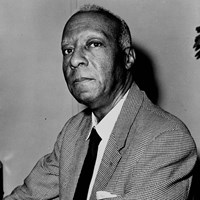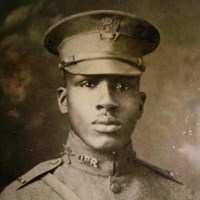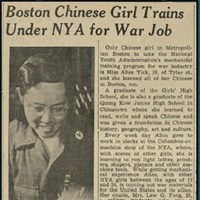
Alfred T. Palmer, Photographer. Library of Congress Prints and Photographs Division. LC-DIG-fsac-1a35287
World War II called upon American industry to essentially stop what it had been doing and dedicate everything towards building tanks, planes and armaments for the Allied forces. Domestic auto production ceased during the war years, nylon stockings were hard to find, and steel was used for pennies to save precious copper. Everything changed and everyone made sacrifices.
America's labor market witnessed tens of millions of workers entering industrial centers from previously service sector or agrarian jobs. Millions of students, retirees, housewives, and unemployed moved into the active labor force. By 1945 the United States had become the world's top industrial producer.
To learn more about the experience of Americans on the home front click on a link to read about the people, places, and events that shaped the war effort at home.
People / Places / Stories
People
- Pullman National Historical Park
A. Philip Randolph
- Locations: Pullman National Historical Park

A. Philip Randolph was a labor organizer and one of the most influential political strategists of the twentieth century. His belief in organized labor’s ability to counter workforce discrimination and his skill in planning non-violent protests helped gain employment advancements for African Americans.
- Charles Young Buffalo Soldiers National Monument
Aaron R. Fisher
- Locations: Charles Young Buffalo Soldiers National Monument

Aaron R. Fisher was born in 1892 in Lyles, Indiana. He enlisted in the Army in 1911. He served with the Buffalo Soldiers of the Twenty-Fourth Infantry during the Punitive Expedition into Mexico. He was an officer in the all-Black 366th Infantry in World War I. He received the Distinguished Service Cross and France’s Croix de Guerre for his actions in France. He was an ROTC instructor at Wilberforce University from 1936 to 1947. He died on November 22, 1985, in Xenia, Ohio.
- Boston National Historical Park
Alfred Brunson Wallace
- Locations: Boston National Historical Park

After growing up in Gulfport, Mississippi, Alfred Brunson Wallace enrolled in the Military Academy as a midshipman in 1935. Over the course of his career in the United States Navy, Wallace served on five destroyers. During World War II, he fought on both the Atlantic and the Pacific fronts. While serving on the USS Cassin Young, Wallace was killed in action from a kamikaze attack.
- Boston National Historical Park
Alice Yick
- Gettysburg National Military Park
Alva B. Johnson
- Sagamore Hill National Historic Site
Archibald Roosevelt
- Boston National Historical Park
Arnold William Erickson
- Boston National Historical Park
Arvel Lee Combs
- Locations: Boston National Historical Park

The profile of Arvel Lee Combs is probably duplicated in the thousands by young men in the US at this time. He came from a rural area, attended some high school, performed in a trade (in Arvel’s case, welding) and enlisted at a young age (18 years old) in the US Navy. He died in action aboard USS Cassin Young following a direct hit from a kamikaze attack on July 30, 1945.
- Boston National Historical Park
Barbara Tuttle Green
- Boston National Historical Park
Ben Conn
Places
- Rosie the Riveter WWII Home Front National Historical Park
Atchison Village
- Rosie the Riveter WWII Home Front National Historical Park
Barbara and Jay Vincent Park
- Locations: Rosie the Riveter WWII Home Front National Historical Park

TThis park is dedicated to Barbara Vincent and her husband Jay who campaigned for public access to 33 miles of Richmond’s shoreline primarily owned by private industry in the 1950s. Together they spearheaded the creation of many coastal access points, including Point Isabel, Point Pinole, and the Bay Trail. The park site once was part of Kaiser Shipyard No. 2 and is now home to the Liberty Ship Monument describing WWII shipyard worker experiences.
- Port Chicago Naval Magazine National Memorial
California: Port Chicago Naval Magazine National Memorial
- Locations: Port Chicago Naval Magazine National Memorial

On the evening of July 17, 1944, residents in the San Francisco east bay area were jolted awake by a massive explosion that cracked windows and lit up the night sky. At Port Chicago Naval Magazine, 320 men were instantly killed when two ships being loaded with ammunition for the Pacific theatre troops blew up.
- Rosie the Riveter WWII Home Front National Historical Park
Filice and Perrelli Cannery
- Locations: Rosie the Riveter WWII Home Front National Historical Park
- Rosie the Riveter WWII Home Front National Historical Park
First Aid Station -Richmond Shipyard No. 3
- Rosie the Riveter WWII Home Front National Historical Park
Ford Assembly Plant
- Locations: Rosie the Riveter WWII Home Front National Historical Park

Out of the three wartime tank depots in the United States, the Ford Assembly Building is the only surviving structure. The Ford Motor Company Assembly Plant in Richmond, California, was the largest assembly plant to be built on the West Coast and its conversion to wartime production during World War II aided the Nation's war effort.
- Rosie the Riveter WWII Home Front National Historical Park
General Warehouse: Richmond Shipyard No. 3
- Rosie the Riveter WWII Home Front National Historical Park
Healthcare, Childcare & Education - Audio Program
- Locations: Rosie the Riveter WWII Home Front National Historical Park

This program is part of an introduction to the history of the park and the WWII Home Front. You can listen to it at home, while driving, before your visit to the park visitor center or as part of the official NPS App driving tour. These files are also available as a free download on our website and can be a great educational tool for your classroom.
- Rosie the Riveter WWII Home Front National Historical Park
Inclusivity & Division in the Workplace - Audio Program
- Rosie the Riveter WWII Home Front National Historical Park
Japanese Incarceration - Audio Program
- Locations: Rosie the Riveter WWII Home Front National Historical Park

This program is part of an introduction to the history of the park and the WWII Home Front. You can listen to it at home, while driving, before your visit to the park visitor center or as part of the official NPS App driving tour. These files are also available as a free download on our website and can be a great educational tool for your classroom.
Stories

During World War II, each branch of the military created a women's reserve and recruited across the country. The US Coast Guard created the SPARS, the women's auxiliary. Recruits from Oklahoma were known as the "Sooner Squadron," and included six Native American women. Their service is a testament to the larger service of Native Americans in World War II.

This lesson is part of a series teaching about the World War II home front in Los Alamos County, New Mexico designated as an American World War II Heritage City. The lesson contains primary sources, a secondary source, and pictures. The sources provide insight on Native American contributions to the home front in Los Alamos, like Dr. Floy Agnes Lee, in contrast to the usually limited employment opportunities for Native Americans. There are also resources on Pueblo pottery.

This lesson is part of a series teaching about the World War II home front with Los Alamos County, New Mexico designated as an American World War II Heritage City. The lesson has photographs, background reading, and interview and memoir excerpts to support learners’ understandings about the home front contributions of the people in Los Alamos. It explores the history of the land and its people, along with sharing perspectives from a child who grew up there and a US soldier.

Los Alamos Lessons Introduction. All three lessons, and the culminating lesson, support the development of understanding the significance of Los Alamos County, New Mexico as an American World War II Heritage City: its impacts to home front efforts with its contributions to The Manhattan Project, and the civilians and service members who contributed to the work. The lessons highlight specific contributions but connect to larger themes and understandings of the U.S. home front.

This lesson is part of a series teaching about the World War II home front with Los Alamos County, New Mexico designated as an American World War II Heritage City. The lesson contains photographs, a newspaper article, and two poems to compare. Los Alamos County was a site of development and final testing for the atomic bomb for the Manhattan Project. Selected resources contribute to learners’ understandings of multiple perspectives of the use and impact of the atomic bomb.

On December 7, 1941 Japan executed a coordinated, multi-pronged attack on the US home front. Within a few hours, they attacked Hawai’i, Guam, Howland Island, Midway Island, Wake Island, and the Philippines. These were not just military targets. They also hit sugar mills and the Honolulu airport in Hawai’i; the Pan Am Hotels in Guam and on Wake Island; and the settlement on Howland Island.

The American government and the American people were aware of the conflicts brewing in Europe, Asia, and Africa in the 1930s. Still hurting from the losses of World War I and in the grip of the Great Depression, there was little congressional or public interest in getting involved. In fact, there were efforts to keep America out of the conflict.

Several changes that took place leading up to and because of World War I influenced America in the Second World War. People, products, ideas, and information moved faster and on a more global scale than any time before. And an increasingly small number of individuals controlled increasingly large methods of production – and wealth.
Last updated: March 20, 2024
Success
Thank you. Your feedback has been received.
Error
alert message













